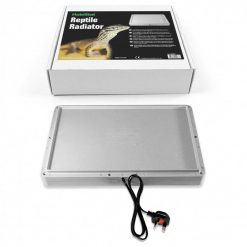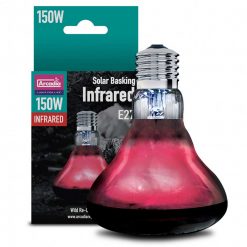Order By 11.30 am Monday-Saturday For Same Day Despatch With Free Standard Delivery Or Upgrade To Express Delivery At Checkout
Arcadia 2nd Generation D3 UV Basking Lamp, 100 Watts
£57.74 Original price was: £57.74.£36.99Current price is: £36.99.
- Provides Heat, Light And UV From A Single Lamp
- Aids The Synthesis Of Vitamin D3
- Helps Prevent Metabolic Bone Disease
- UVB And A Balanced UVA Similar To Wild Exposure
- No External Ballast Required
- Lamp Size: Height 16cm X Diameter 12cm
Out of stock
Arcadia D3 UV Basking Lamps provide UV-B, UV-A, visible light & infrared energy (heat) from a single lamp.
Many species of reptile and Amphibian require a warm spot under which they can bask and become fully energised with heat and Ultra Violet.
This is an ideal all-in-one lamp for providing heat, light and UV.
Arcadia also produces their D3 basking lamps in 2 other wattages – Mercury Vapour D3 UV Basking Lamp – 80 Watt, and Mercury Vapour D3 UV Basking Lamp – 160 Watt.
IMPORTANT SAFETY INSTRUCTIONS – READ BEFORE OPERATING THE LAMP
This lamp emits Ultraviolet radiation in both UVA and UVB wavebands. Do not stare directly at the lamp while in use and avoid prolonged direct exposure to the lamp at close range.
RISK OF BURNING – The lamp gets very hot in normal operation, do not touch the lamp when it is operating and allow at least 15 minutes for it to cool down after switching off before attempting to handle the lamp, or trying to move or adjust the fixture.
FIRE HAZARD – Do not allow the lamp to come into contact with any combustible materials, the lamp should be used in an appropriate securely mounted protective fixture and located away from curtains, soft furnishings and other flammable materials.
Do not splash the lamp with water or other liquids – if the glass of the lamp breaks or cracks, unplug the fixture and allow the lamp to cool before removing and replacing the lamp.
Only for use with an appropriately rated luminaire or fixture with a ceramic E27 lamp holder – this lamp MUST NOT be used with conventional domestic luminaires or fixtures, as these are not designed to cope with the operating temperature of the lamp and will pose a fire hazard.
Installation And Care Of The D3 Basking Lamp
The D3 Basking lamp is designed for use above large well-ventilated vivaria.
We suggest a minimum width of 60cm (24“) and length of 100 – 120cm (36” – 48“) to ensure there is an adequate temperature gradient and cool area away from the lamp.
To ensure safe UV exposure, the MINIMUM distance from lamp to reptile is 20cm (8”) for this the 100W Lamp and 30cm (12“) for the 160W Lamp.
Given that many basking species require a raised basking zone (a shelf, rock or branch), in practice this means that the minimum height for the vivarium is likely to be around 50 – 60cm (20” – 24“).
See below for further details on lamp positioning.
- Only use with an appropriately rated fixture or luminaire with ceramic lamp holder. For this Lamp we recommend the Arcadia 20cm Clamp Lamp available in either Arcadia 20cm Clamp Lamp Stainless Steel Finish or the Arcadia Graphite Finish 20cm Clamp Lamp or if a clamp lamp is no suitable for your installation type the Arcadia Ceramic Lamp Holder and Bracket Pro
- Ensure the luminaire or fixture containing the lamp is securely fixed and cannot come in to contact with flammable materials. The chosen location for the lamp needs to be well ventilated, as a build up of excessive heat or humidity will shorten lamp life.
- Keep the lamp away from water spray or mist.
- Avoid knocks and vibration to the lamp, particularly when the lamp is illuminated, as the lamp elements are easily damaged and frequent vibration may shorten lamp life.
- For long operational life orient the lamp pointing straight downwards. Operating the lamp if it is tilted beyond 20 degrees from the vertical will severely shorten its life.
- This lamp is not suitable for use with dimming controls or thermostats. It can be used with a safety thermal cut out (which switches the lamp off until reset manually, if the vivarium exceeds a designated temperature), but regular switching will shorten lamp life. Remember that the lamp will take up to 15 minutes to re-light after switching off.
Creating The Correct Environment For Your Reptile
- The Lamp should be installed so as to ensure a MINIMUM distance of at least 20cm (8”) for this 100W Lamp and at least 30cm (12”) for the 160W Lamp, when measured from the lamp surface to the reptile. NB: this distance is not from the lamp to the floor, or to the basking branch or shelf – it is from the lamp to the closest part of the reptile’s head or body when basking. This is a safe MINIMUM distance, to avoid over-exposure to UVB. The actual distance used is normally greater than this, and should be determined by the basking temperature and UV Index required by your species. As a very rough guide, species which bask in full sun may require up to UV Index 3 – 5 in the basking zone; occasional baskers and forest species generally require lower levels, between UV Index 1 – 3 in the basking zone. (See chart on box for distances at which these levels are reached by an ‘average’ lamp.)
- For best results combine with an Arcadia Halogen Basking Spot Lamp which is connected to an appropriate thermostat or thermo-regulator. This will allow accurate regulation of the basking spot temperature without needing to raise or lower the D3 Basking lamp, and improve colour rendition in the basking area.
- Install the lamps at one end of the vivarium so as to create a temperature gradient within the enclosure, this allows the animal to regulate their body temperature by moving into or out of the basking area.
- Before installing the reptile, the temperatures must be monitored and the lamps adjusted until the temperatures in the basking zone, in the cool retreat, and throughout the rest of the vivarium are suitable for your species. Check with your retailer or species guidebook, what the optimum basking and ambient temperature of the vivarium should be. The thermostat probe should be placed in the sheltered coolest part of the vivarium, and the thermostat set at the highest acceptable temperature for the cool retreat. Then, should the vivarium temperature rise higher, the Halogen Basking Spot Lamp will dim sufficiently to keep the cool retreat at a safe temperature. At all other times it will be fully alight, providing the optimum heat and light required to complement the Arcadia D3 Basking Lamp.
- Ensure that your reptile has an area of lower light intensity within the vivarium and a shaded area, so that they can regulate their exposure to the basking lamp. If your animal spends the majority of its time in the shaded/darker area of the vivarium, check the temperature gradient; the basking zone may be too hot. If this does not appear to be the problem, the UV light may be too intense for your reptile. Some reptiles, particularly light-coloured or “albino” morphs, are more sensitive to UVB than others. If your reptile avoids the light or keeps its eyes closed for long periods, this may be the cause. We then suggest increasing the height of the Arcadia D3 Basking Lamp above the basking area.
- Extra care should be taken with climbing animals to ensure they cannot reach the lamps as their surfaces get hot enough to cause potentially fatal burns to reptiles, and at distances closer than 12 inches, the UVB radiation from the Arcadia D3 Basking Lamp is excessive. Either locate the fixture so that it is impossible for your animal to reach it, or ensure the fixture or luminaire selected offers sufficient protection and use a mesh guard if necessary.
- The photoperiod (the period of exposure to light each day) varies with species and country of origin. Tropical species often require a 12-hour day; subtropical and temperate species may require 8-10 hours in winter and 12-14 hours in summer. Check with your retailer or with an established reference guidebook for your species.
Operating The Lamp
- The lamp will take 5 minutes to get to its normal operating condition. While it is ‘warming up’ the lamp may appear to flicker or change colour as the different elements in the lamp reach their operating temperature – this is normal.
- Once lit, if the lamp is turned off (even briefly) it must cool down before it will re-light. If the power remains switched on, it will re-ignite spontaneously as soon as it is cool enough. This can take 10 – 15 minutes; this is normal.
- The lamp is rated for 230-240 Volts AC at 50Hz.; do not attempt to operate the lamp at a different voltage or frequency.
- As with all reptile lamps, the amount of UV light emitted by the D3 Basking Lamp will decrease over time, so it is important to check the UV levels emitted by the lamp periodically to ensure your animal receives sufficient UVA and UVB exposure. If you do not have access to a UVB meter to ascertain when the lamp is approaching the end of its useful life, then you should replace the lamp every 12 months to ensure your animal continues to receive enough UV.
End of Lamp Life
The D3 Basking Lamp contains mercury, and cannot be disposed of with normal household waste, it should be deposited in the lamp recycling area at your local civic recycling centre or taken to any approved recycling point for lamps containing mercury.
Proper disposal of this product helps to prevent potential negative consequences for the environment and human health.









